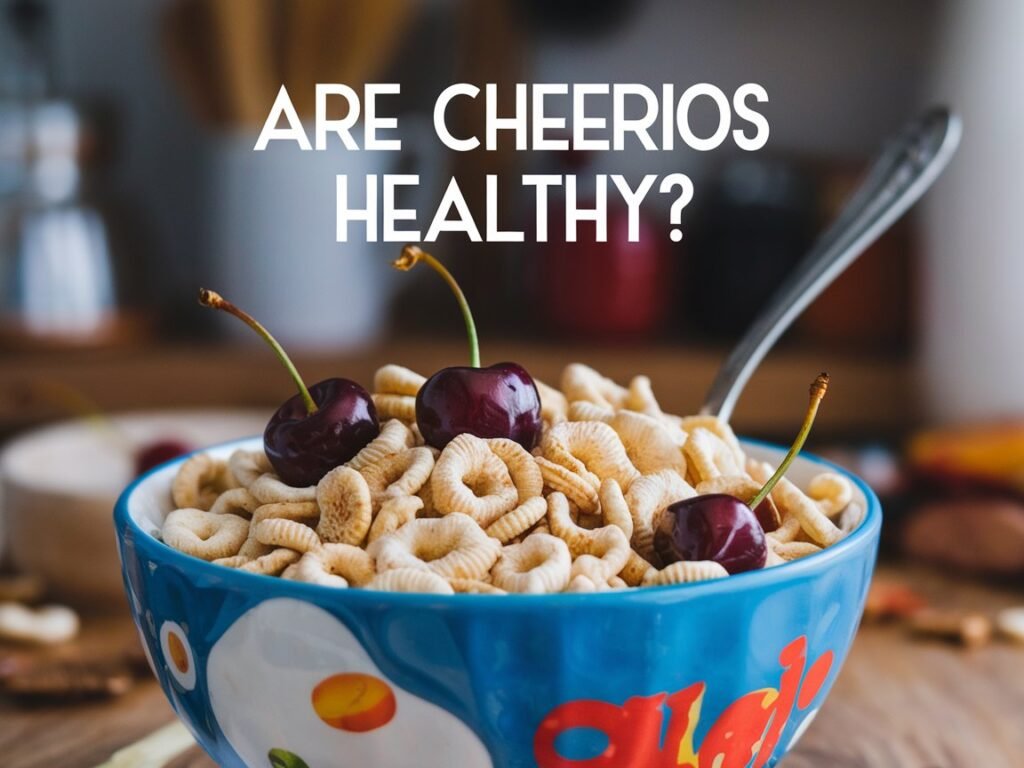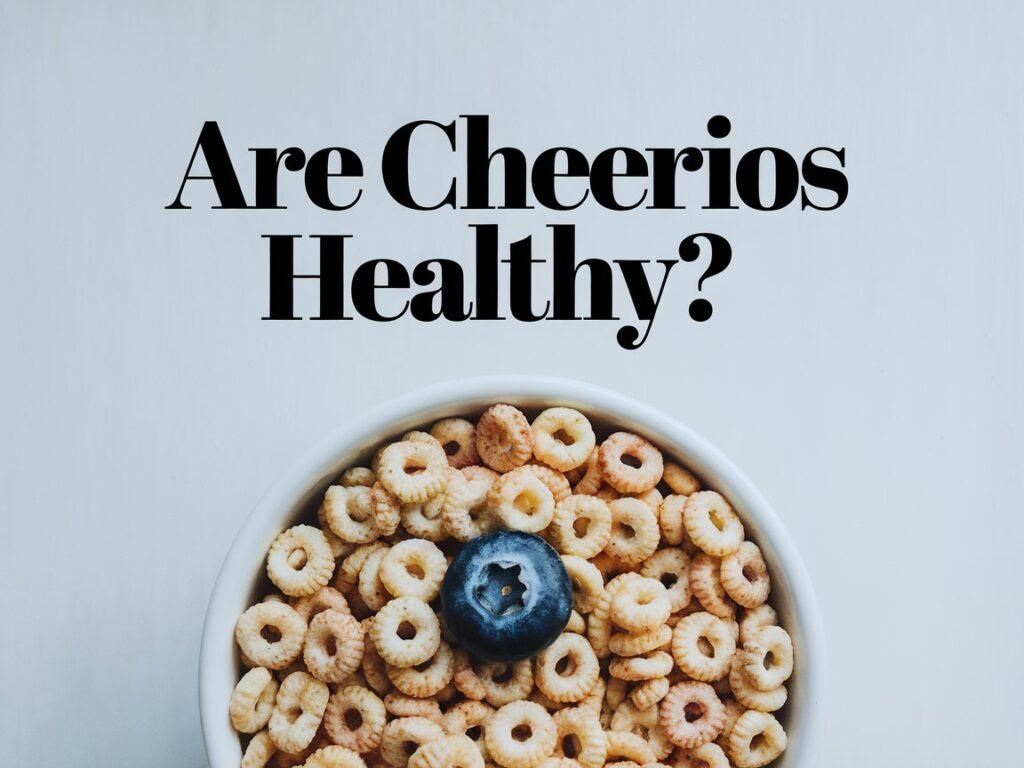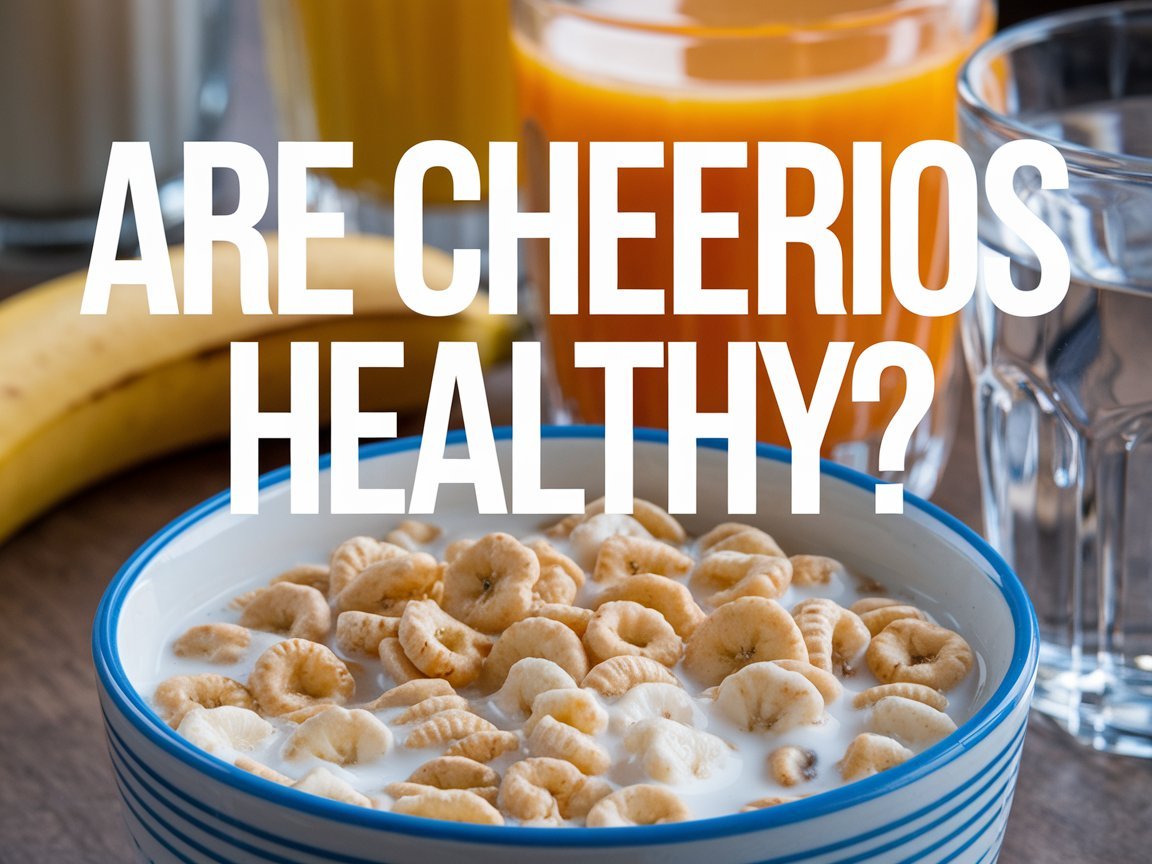A Classic Breakfast Staple
When I think back to my childhood, a bowl of Cheerios is one of the first things that comes to mind. They were a staple in our pantry—simple, reliable, and always ready for a quick breakfast. Cheerios have been a household favorite since their debut in 1941, and for many, they represent a comforting, nostalgic start to the day.
But as I got older and became more aware of nutrition and health, I started to wonder: Are Cheerios actually healthy? It seems like such a straightforward question, but as I dug deeper, I realized that the answer is a bit more complicated.
The Debate on Cheerios’ Healthiness
Cheerios are often marketed as a heart-healthy cereal, thanks to their whole grain content. But is this enough to make them a truly healthy choice? Let’s break down what makes Cheerios tick and why this debate persists.
Nutritional Breakdown of Cheerios
When we talk about Are Cheerios healthy, we have to look at the specifics of their nutrition.
Plain Cheerios are generally praised for being low in calories and made from whole grains. They offer a decent amount of fiber and iron, which are beneficial for heart health and overall digestion. For instance, a typical serving of plain Cheerios contains about 100 calories, 3 grams of fiber, and 2 grams of iron. This makes them a solid option if you’re aiming for a heart-healthy diet or looking to increase your fiber intake.
However, not all Cheerios varieties are created equal. For instance, Chocolate Cheerios and Honey Nut Cheerios bring their own set of nutritional facts into the mix. Chocolate Cheerios might sound tempting with their sweet taste, but they also contain added sugars that can detract from their health benefits. Similarly, Honey Nut Cheerios are sweeter and have more sugar compared to plain Cheerios. This can be a concern if you’re trying to manage your sugar intake.
Calories and Portion Sizes
Another important factor in determining if Cheerios are healthy is understanding their caloric value. A bowl of Cheerios calories can vary based on portion size and added ingredients. Plain Cheerios are relatively low in calories, but if you pour a large bowl or add high-calorie toppings, the calorie count can quickly add up. It’s essential to keep portion sizes in check to avoid consuming more calories than intended.
Special Considerations
For those with specific dietary needs, such as managing diabetes or looking for high-fiber options, Cheerios can fit into your diet but with some considerations. Are Cheerios good for diabetics? The answer depends on the variety and how they’re consumed. For example, Multigrain Cheerios might offer more fiber than plain Cheerios, but they also contain carbohydrates that need to be monitored.
Additionally, if you’re dealing with constipation, you might wonder about the role of Cheerios. Cheerios and constipation is an interesting topic because the fiber in Cheerios can aid digestion, but it’s crucial to balance it with plenty of water and other high-fiber foods.
Comparing Cheerios to Other Breakfast Options
When comparing Cheerios to other breakfast choices, like oatmeal, it’s clear that both have their benefits. Cheerios vs. oatmeal often comes down to personal preference and dietary goals. While Cheerios are convenient and low in calories, oatmeal typically offers more fiber and can be more filling. Each has its place in a balanced diet, but the healthiest choice depends on your individual needs.
Cheerios can be a part of a healthy diet, especially the plain variety with its whole grain goodness and relatively low calorie count. However, varieties with added sugars, like Chocolate Cheerios and Honey Nut Cheerios, might not be the best choice if you’re focused on reducing sugar intake. So, the next time you reach for a box of Cheerios, consider which variety best aligns with your health goals and dietary needs.
Nutritional Breakdown of Cheerios
When you open a box of Cheerios, what exactly are you getting in terms of nutrition? Cheerios have been a popular breakfast choice for many years, and their nutritional profile varies depending on the variety you choose. Let’s break down what you need to know to determine if Cheerios are really a healthy choice for you.
Cheerios Plain
Nutritional Value and Ingredients
Plain Cheerios are known for their simplicity and whole grain goodness. They’re made primarily from whole grain oats, which is a significant factor in their nutritional profile. A typical serving of Plain Cheerios (1 cup) contains about 100 calories. It offers 3 grams of fiber, which is excellent for digestion, and provides 2 grams of iron, contributing to your daily iron needs.
The ingredient list is straightforward: whole grain oats, sugar, salt, and a few vitamins and minerals. There are no artificial flavors or colors, which makes Plain Cheerios a relatively clean option in the cereal aisle.
How Many Calories in Cheerios
When you’re considering how many calories in Cheerios, Plain Cheerios stand out for their low calorie count. Each serving has around 100 calories. This makes them a good choice if you’re looking to keep your calorie intake in check while still getting a nutritious start to your day. Just remember that the calorie count can change if you add milk or other toppings.
Are Plain Cheerios Healthy?
So, are Plain Cheerios healthy? The answer is generally yes, especially if you’re choosing them over other more sugary cereals. They offer whole grains, fiber, and are relatively low in calories. However, it’s crucial to balance them with other nutritious foods throughout the day to ensure a well-rounded diet.
Cheerios Varieties
Cheerios Peanut Butter Chocolate: Ingredients and Nutrition
Now let’s dive into Cheerios Peanut Butter Chocolate. This variety adds a fun twist with the flavor of peanut butter and chocolate. But what about its nutritional value? This variety contains added sugars and fats compared to Plain Cheerios. A serving of Peanut Butter Chocolate Cheerios has around 140 calories, 8 grams of sugar, and 3 grams of protein. While it might be a treat for your taste buds, it’s worth keeping in mind that the added sugars can make it less ideal if you’re watching your sugar intake.
Chocolate Cheerios Cereal: Chocolate Cheerios Nutrition Label and Benefits
Chocolate Cheerios are another sweet variation that many enjoy. Looking at the Chocolate Cheerios nutrition label, each serving has about 120 calories, with 8 grams of sugar and 3 grams of protein. The addition of cocoa gives them that rich chocolate flavor, but the sugar content is higher than Plain Cheerios. If you’re considering them for their taste, be mindful of the sugar content and how it fits into your overall diet.
Multigrain Cheerios: Nutritional Content and Benefits
Multigrain Cheerios offer a bit more variety in terms of grains. They contain whole grain oats along with other grains like corn, rice, and barley. Each serving provides 110 calories, 4 grams of fiber, and 2 grams of protein. The mix of grains can offer a slightly different nutrient profile and may be a good option if you’re looking for more variety in your diet. The added grains also help in increasing the fiber content, which can be beneficial for digestion.
Honey Nut Cheerios: Ingredients, Nutrition, and Health Considerations
Lastly, let’s talk about Honey Nut Cheerios. This variety is known for its sweet, honeyed flavor, which comes from added honey and sugar. A serving of Honey Nut Cheerios contains around 140 calories, 12 grams of sugar, and 2 grams of protein. While they provide a pleasant taste and can be appealing, the higher sugar content is something to consider if you’re trying to limit your sugar intake. The added sugars can impact the overall healthiness of this cereal compared to Plain Cheerios.
Health Benefits of Cheerios
When you think of Cheerios, the first thing that might come to mind is a simple, classic breakfast. But behind that iconic shape and familiar taste lies a range of health benefits. As I discovered on my journey to understand more about the foods we eat, Cheerios offer more than just comfort—they come packed with some nutritional perks. So, let’s dive into the health benefits of Cheerios, focusing on their whole grain content, fiber, and iron.
Whole Grain Content

Is Cheerios Whole Grain?
One of the standout features of Cheerios, particularly the original Plain Cheerios, is that they are made from whole grain oats. Is Cheerios whole grain? Absolutely. This whole grain content is a key part of what makes Cheerios a popular choice for health-conscious individuals.
Nutritional Value of Whole Grain Cheerios
Whole grains are celebrated for their nutrient-rich profiles, and Cheerios are no exception. Nutritional value of whole grain Cheerios includes essential vitamins and minerals. Each serving of Plain Cheerios provides a good dose of dietary fiber and iron. Whole grain oats are known for their complex carbohydrates, which provide sustained energy throughout the morning.
The whole grain content in Cheerios is also linked to heart health benefits. Whole grains have been shown to reduce the risk of heart disease. So, when you’re eating a bowl of Cheerios, you’re not just filling up; you’re potentially giving your heart a little boost.
Benefits of Whole Grain for Heart Health and Digestion
Eating whole grains like those found in Cheerios can have several health benefits. Benefits of whole grain for heart health and digestion include improved cholesterol levels and better digestion. Whole grains help lower LDL cholesterol (the “bad” cholesterol) and keep your digestive system running smoothly thanks to their high fiber content. This means that Cheerios can support both cardiovascular health and digestive health with each bowl.
Fiber and Iron
Cheerios as a Source of Fiber
Another crucial aspect of Cheerios is their fiber content. Cheerios as a source of fiber is particularly significant because fiber plays a vital role in maintaining digestive health and can help with weight management. A serving of Plain Cheerios contains about 3 grams of fiber, which contributes to your daily fiber intake. Fiber helps keep you full longer, which can be beneficial if you’re trying to manage your weight.
Iron Content in Cheerios and Its Health Benefits
Iron is another important nutrient found in Cheerios. Iron content in Cheerios and its health benefits are worth noting because iron is essential for transporting oxygen throughout your body and maintaining energy levels. Each serving of Plain Cheerios provides around 2 grams of iron, which helps in preventing anemia and supporting overall energy and stamina.
In summary, Cheerios offer notable health benefits beyond their classic taste. The whole grain content contributes to heart health and efficient digestion, while the fiber and iron content support long-term well-being. Whether you’re enjoying Plain Cheerios or exploring other varieties, understanding these nutritional benefits can help you make informed choices about incorporating them into your diet.
Potential Drawbacks of Cheerios
When I first fell in love with Cheerios, it was all about the convenience and nostalgia. But as I dug deeper into the world of nutrition, I realized that even beloved classics like Cheerios come with their own set of potential drawbacks. Let’s explore the not-so-sweet side of this iconic cereal and find out if there are any reasons to think twice before reaching for that bowl.
Added Sugars
Do Cheerios Have Added Sugar?
One of the big questions I had was, do Cheerios have added sugar? The answer varies depending on the variety you choose. For the original Plain Cheerios, the sugar content is minimal. They’re sweetened lightly and focus more on the natural taste of whole grain oats. However, not all Cheerios are created equal.
When you venture into varieties like Honey Nut Cheerios or Chocolate Cheerios, you’ll find that added sugars become more prominent. Honey Nut Cheerios, for instance, have a sweeter profile due to added honey and sugar, which contribute to their signature taste. This increased sugar content might be a concern if you’re watching your sugar intake.
Comparison of Sugar Content in Different Cheerios Varieties
To get a clearer picture, let’s compare the sugar content in different Cheerios varieties. Plain Cheerios have about 1 gram of sugar per serving, which is quite low. On the other hand, Honey Nut Cheerios contain around 12 grams of sugar per serving. Chocolate Cheerios fall somewhere in between, with about 8 grams of sugar per serving. This variation shows that while Plain Cheerios are relatively low in sugar, other varieties might not be as friendly if you’re trying to cut down on sweeteners.
Are Cheerios Fattening?
Are Cheerios Good for Weight Management?
Now, let’s tackle a common concern: are Cheerios good for weight management? This really depends on the variety and how you incorporate them into your diet. Plain Cheerios, with their low sugar and calorie content, can be a good choice if you’re managing your weight. They’re filling due to their fiber content, which can help you feel full longer and potentially reduce overall calorie intake.
However, if you’re enjoying varieties with higher sugar content, like Honey Nut Cheerios or Chocolate Cheerios, they might not be as supportive of weight management. The extra sugars can add up and contribute to higher calorie consumption, which is something to be mindful of if weight management is a goal.
Caloric Content and Serving Sizes
When it comes to caloric content and serving sizes, Plain Cheerios are relatively modest. A serving size of Plain Cheerios typically contains about 100 calories, which is fairly low for a breakfast cereal. But as with any food, the overall impact on your diet depends on portion sizes and additional ingredients like milk or toppings. If you’re pouring a large bowl of Honey Nut Cheerios, you might end up with more calories than you bargained for.
In summary, while Cheerios have their merits, it’s important to be aware of their potential drawbacks. Added sugars in varieties like Honey Nut and Chocolate Cheerios can impact your overall sugar intake. Additionally, while Plain Cheerios are generally supportive of weight management, other varieties with higher sugar content might not be as helpful. Understanding these factors can help you make more informed choices about incorporating Cheerios into your diet.
Special Considerations
When it comes to health and nutrition, no one-size-fits-all answer exists, and the same goes for Cheerios. While they are a staple in many households, it’s essential to consider specific dietary needs and conditions. I found myself wondering about Cheerios’ suitability for different health scenarios. Here’s what I discovered about Cheerios, especially for those managing diabetes or dealing with constipation.
Cheerios for Diabetics
Are Cheerios Good for Diabetes?
As someone who’s had friends and family manage diabetes, I wanted to understand, are Cheerios good for diabetes? It turns out, Cheerios can be part of a diabetes-friendly diet, but with some caveats. Plain Cheerios are a better option due to their lower sugar content and whole grain oats. Whole grains can help stabilize blood sugar levels, which is a crucial consideration for anyone with diabetes.
However, it’s important to watch portion sizes and be mindful of the varieties you choose. While Plain Cheerios have a moderate glycemic index, other types like Honey Nut Cheerios or Chocolate Cheerios have higher sugar levels, which might not be as beneficial.
Glycemic Index of Cheerios and Its Impact
To really understand the impact, let’s talk about the glycemic index of Cheerios and its impact. The glycemic index (GI) measures how quickly a food raises blood sugar levels. Plain Cheerios have a moderate GI, which means they cause a slower rise in blood sugar compared to high-GI foods. This can be helpful for maintaining stable blood sugar levels throughout the day.
On the flip side, Cheerios varieties with added sugars, like Honey Nut or Chocolate Cheerios, have a higher GI. This can lead to quicker spikes in blood sugar, which might not be ideal for someone managing diabetes. Always keep an eye on your blood sugar responses and adjust your choices accordingly.
Cheerios and Constipation
Do Cheerios Help with Constipation?
Now, let’s address a more common issue: do Cheerios help with constipation? If you’ve ever experienced constipation, you might be looking for easy dietary solutions. Cheerios can be surprisingly helpful in this area. Plain Cheerios are a good source of dietary fiber, which is essential for promoting regular bowel movements.
The fiber in Cheerios adds bulk to your stool and helps keep things moving in your digestive tract. While not a miracle cure, adding Cheerios to your diet can contribute to overall digestive health and may help alleviate occasional constipation. Of course, drinking plenty of water and including other fiber-rich foods in your diet are also important.
In conclusion, Cheerios can offer benefits for various health needs, but it’s all about making the right choices. For diabetics, Plain Cheerios can be a part of a balanced diet due to their moderate glycemic index and whole grain content. However, for those with constipation, the fiber in Cheerios can be a helpful addition to your daily intake. Just remember, moderation and variety are key in any balanced diet.
Comparing Cheerios to Other Options

When it comes to breakfast cereals, Cheerios have carved out a special place in many people’s hearts and pantries. But how do they stack up against other popular breakfast choices? As someone who’s gone through countless breakfast trials and debates, I’ve explored how Cheerios compare to other options. Let’s dive into this comparison and see where Cheerios stand in the world of breakfast cereals.
Cheerios vs. Other Breakfast Cereals
Cheerios vs. Oatmeal for Lowering Cholesterol
One of the biggest claims to fame for Cheerios is their role in heart health, particularly in lowering cholesterol. But how do they measure up when compared to oatmeal, another breakfast hero in the battle against high cholesterol?
Cheerios are known for their whole grain oats, which can help lower LDL cholesterol levels thanks to their soluble fiber content. This is because the soluble fiber in Cheerios binds to cholesterol in the digestive system and helps remove it from the body. On the other hand, oatmeal is often hailed as a champion in the fight against cholesterol. It’s also rich in soluble fiber, particularly beta-glucan, which has been extensively studied for its cholesterol-lowering effects.
While both Cheerios and oatmeal offer heart-healthy benefits, oatmeal might have a slight edge due to its higher concentration of beta-glucan. However, Cheerios still provide a convenient and tasty way to get some of these benefits, especially for those who prefer a crunchy cereal over a warm bowl of oats.
How Cheerios Compare with Other Cereals in Terms of Health Benefits
So, how do Cheerios stack up against other cereals in terms of overall health benefits? Let’s take a closer look.
- Whole Grain Cheerios vs. Processed Cereals: Cheerios are made from whole grains, which means they offer more fiber and nutrients compared to many processed cereals. Many processed cereals are high in sugars and low in fiber, making Cheerios a healthier choice in this regard.
- Cheerios vs. High-Sugar Cereals: Unlike high-sugar cereals, which can lead to spikes in blood sugar and contribute to weight gain, Cheerios generally have a lower sugar content. This makes them a better option for those looking to manage their sugar intake and maintain stable energy levels throughout the morning.
- Cheerios vs. Granola: Granola is often perceived as a healthier option, but it can be surprisingly high in added sugars and fats. Cheerios, especially the plain variety, can be a lower-calorie and less sugary alternative, which might be better for those watching their weight or sugar intake.
In the grand breakfast cereal showdown, Cheerios hold their ground with their whole grain benefits, lower sugar content, and heart-healthy qualities. While oatmeal might offer slightly more in terms of cholesterol-lowering benefits due to its beta-glucan content, Cheerios provide a versatile and health-conscious choice for those seeking a convenient, crunchy start to their day.
So, whether you’re weighing Cheerios against oatmeal or other breakfast cereals, consider your specific health goals and preferences. Cheerios can be a valuable part of a balanced diet, offering a nutritious option that aligns with a variety of dietary needs.
Frequently Asked Questions

When it comes to breakfast cereals, Cheerios often pop up in conversations, whether you’re considering dietary needs, daily consumption, or kid-friendly options. Having explored various aspects of Cheerios, I found that several common questions arise. Here’s a deeper look into these queries, from vegan considerations to daily consumption and suitability for children.
Are Cheerios Vegan?
Ingredients and Vegan Considerations
One question that frequently comes up is, are Cheerios vegan? This is a bit of a mixed bag. The basic, Plain Cheerios are often considered vegan-friendly since they primarily consist of whole grain oats and a few other plant-based ingredients. The main ingredients in Plain Cheerios are whole grain oats, cornstarch, sugar, and salt.
However, it’s important to look beyond just the ingredients list. Some vegans might be concerned about cross-contamination or specific processing practices. For instance, Cheerios are produced in facilities that process dairy and other animal products, which might be a deal-breaker for strict vegans.
Additionally, some flavors, like Honey Nut Cheerios, include honey, which is not considered vegan because it’s an animal byproduct. If you’re strictly adhering to a vegan diet, sticking to the original Plain Cheerios and checking labels carefully for any new varieties is advisable.
Is Cheerios Safe to Eat Daily?
Health Implications of Eating Cheerios Every Day
Another common question is, is Cheerios safe to eat daily? I’ve had my fair share of Cheerios breakfasts and, from personal experience, I can say that enjoying Cheerios regularly is generally safe. Cheerios provide a balanced amount of whole grains, fiber, and essential nutrients.
Eating Cheerios every day can be part of a healthy diet, especially if you choose varieties with lower added sugars and focus on options like Plain Cheerios. The whole grains and fiber content can contribute positively to heart health and digestion.
However, as with any food, variety is key. Relying solely on one type of food might lead to nutritional imbalances. It’s a good idea to mix in other nutrient-rich foods and ensure you’re getting a range of vitamins and minerals from different sources.
Cheerios for Children
Are Cheerios a Good Choice for Kids?
Finally, are Cheerios a good choice for kids? As a parent, I’ve often considered this question, especially with my own kids who love the crunch of Cheerios. In general, Cheerios can be a nutritious option for children. The Plain Cheerios provide whole grains and are low in sugar, making them a better choice compared to many other sugary cereals on the market.
They are also easy to digest and come in a size that’s manageable for little hands. Many parents find them a convenient, relatively healthy option for breakfast or snacks.
However, it’s important to watch for added sugars in flavored varieties and ensure that Cheerios are part of a balanced diet that includes a variety of fruits, vegetables, and proteins.
In conclusion, Cheerios are a versatile and often healthy choice, whether you’re considering vegan options, daily consumption, or feeding them to children. As always, the key is moderation and variety to ensure a well-rounded diet.
Conclusion
After diving deep into the world of Cheerios, from their nutritional breakdown to their potential health benefits and drawbacks, it’s clear that this iconic breakfast cereal has a lot to offer. Whether you’re a lifelong fan or just considering adding it to your morning routine, let’s recap what we’ve learned about Cheerios and their place in a healthy diet.
Summary of Key Points
First off, Cheerios are a popular choice because of their simplicity and versatility. They come in various flavors, but the Plain Cheerios stand out for their minimal ingredients and whole grain benefits. Their whole grain content is a significant plus, as it provides essential fiber and nutrients that contribute to heart health and aid in digestion. The Cheerios are often praised for being a lower-sugar alternative compared to many other cereals on the market.
However, not all Cheerios are created equal. Chocolate Cheerios, Peanut Butter Cheerios, and even Honey Nut Cheerios introduce added sugars and flavorings that can affect their overall healthiness. While they still offer some nutritional benefits, they may not be as beneficial as the plain variety, especially if you’re monitoring sugar intake or managing weight.
When comparing Cheerios to other breakfast options, they hold their own fairly well. They are generally healthier than many processed cereals and can be a good alternative to higher sugar choices. However, oatmeal might have a slight edge in terms of cholesterol-lowering benefits due to its higher beta-glucan content.
Final Thoughts on Whether Cheerios Are Healthy
So, are Cheerios healthy? The answer is somewhat nuanced. On one hand, Plain Cheerios are a nutritious choice due to their whole grain content, lower sugar levels, and fiber. They can be part of a balanced diet and offer various health benefits, including heart health and digestion support. On the other hand, flavored varieties like Chocolate Cheerios and Honey Nut Cheerios should be consumed with a bit more caution due to their added sugars and potential impact on overall health.
Recommendations for Incorporating Cheerios into a Balanced Diet
To make the most of Cheerios in your diet:
- Stick to Plain Cheerios: They are the most straightforward and healthiest option. The whole grain content and lower sugar make them a great choice for daily consumption.
- Watch Portions and Add-Ins: Be mindful of the serving size and consider adding fruits, nuts, or seeds to boost the nutritional value.
- Mix with Other Breakfast Options: Combine Cheerios with other nutrient-dense foods like yogurt or fresh fruit to create a more balanced meal.
- Be Cautious with Flavored Varieties: If you enjoy Honey Nut Cheerios or Chocolate Cheerios, keep these as occasional treats rather than everyday staples.
References
To support the information provided, here are some sources and studies that offer further insight into the health benefits and nutritional content of Cheerios:
- General Mills Official Nutritional Information: For detailed ingredient lists and nutritional breakdown of different Cheerios varieties.
- American Heart Association: Studies on the benefits of whole grains for heart health.
- Journal of Nutrition: Research on fiber’s role in digestion and overall health.
In summary, Cheerios can be a healthy addition to your breakfast routine, especially when you opt for the plain variety and use them as part of a balanced diet. Whether you’re looking for a quick breakfast or a nutritious snack, Cheerios offer a reliable option, provided you make mindful choices regarding flavors and portions.





[…] plays a role in advancing competence within ABA therapy. It is essential for practitioners to actively seek feedback from clients and their families to […]